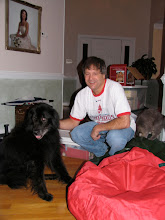For a good 4 to 5 months I worked on installing the stringers, each one getting easier as I gained experience and got closer to the top most stringers(which, in the photos, are towards the bottom, because the boat is started upside down). The last couple of rows of stringers had less twist and torque and were easier to glue, clamp and screw to the stem, bulkheads, frames and transom. I really took my time though because these were the frame for the boat and, as go the frames, so goes the boat. So I worked hard to achieve symmetry and fair lines.
Finally, I was ready to plank. I chose African Okoume 1/4" 5 ply plywood, marine grade. Arch ordered this for me through his supplier in Florida. I ordered 6 sheets of the 8 x 5 ft. sheets instead of the recommended 5, allowing for mistakes and knowing that more is always better in boat building, when it comes to wood supplies. Planks were started at the bottom of the boat, the first of which is called the garboard plank. It is fitted to the false keel and the first stringer. The keel had to be beveled first though, so that the planks would overlap at the bottom properly and curve upwards towards the first stringer. Beveling took a lot of time and rechecking. I used my block plane and files and obtained nice bevels on both sides of the keel. I was especially careful at the part of the keel that was widened to accomodate the slot for the centerboard. I had already cut this slot after gluing a short strip of fir wood to the appropriate site on the keel. When I was satisfied with the shape of the bottom of the keel I started measuring and cutting for the garboards. Since the plywood sheets were just 8' long I had to scarf the ends of the cut pieces of plank to get the necessary 14' length. Not so hard , the scarfing, really. Again, I used the block plane and at the edge of the planks to be joined I made 2' wide scarfs so that the wood came to a sharp, triangular feathered edge. These edges, once the planks were installed would overlap and be secured by glue and form a full thickness 2 " wide overlapping bond. Getting the planks shaped properly to fit between the keel and stringers was the next challenge and required dry clamping the oversized planks to their ultimate destination and tracing their shapes from underneath the boat. This done, the plank, was taken off and cut to a size closer to the final width it would be at. A note about planking a curved round bottom lapstrake boat: these planks are not what they seem. They are not just straight pieces of plywood. Rather, they are weirdly shaped so that they curve properly up and down and from side to side.Most of them look like trapezoids once cut to size. Arch does a great job of describing how to get the shapes right using the under the boat tracing technique, with the stringers as guides. The edge of the garboard plank facing the botttom of the boat was fitted and glued and screwed to the starboard side of the keel first. The other (topmost) edge was glued and screwed to the first with the edge about 1/4' proud of the edge of the stringer. This extra bit of wood would later be shaved off to perfectley match the edge and curve of the stringer. Once the starboard garboard was in place, allowing for 2 days of drying time for complete curing of the glue, I made the bevel of the bottom most ege using files and a sanding block so that the port garboard could overlap it perfectly. This done, the port garboard was fitted, with both edges about 1/4" proud of the starboard garboard beveled edge and portside bottom most stringer. I should add that I was putting on the aft parts of the garboards first, with the fore parts to come next as the boards were not long anough and there would be a scarfed on botrh boards to join them. The fore parts of the garboards were installed with the scarfed ends of the already installed aft plank being overlapped by the fore plan scarfed edge. In reading Arch's manual and watching his video you get excellent instruction on how to do this. I did obtain other resources to read about wooden boat building. By doing a search on Amazon.com I found a number of helpful references.
Subscribe to:
Post Comments (Atom)




No comments:
Post a Comment